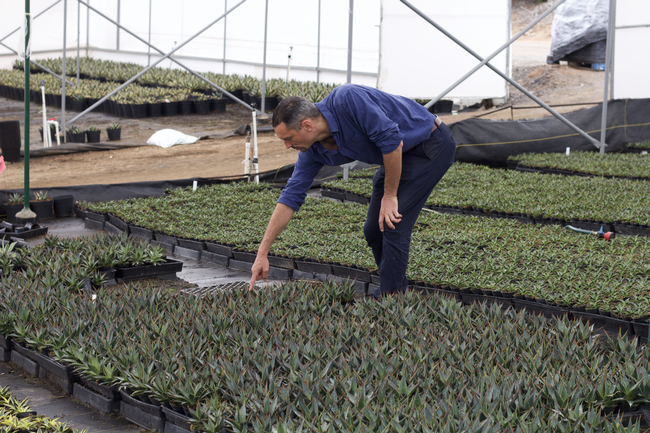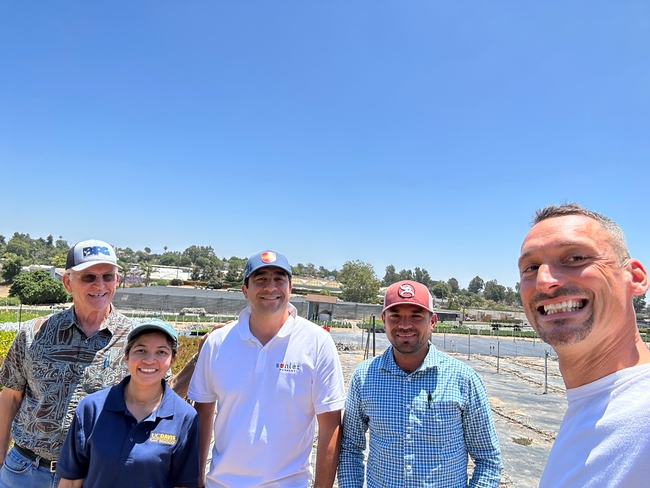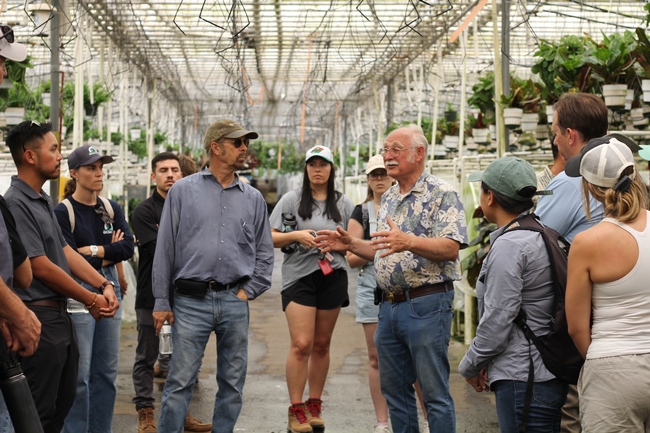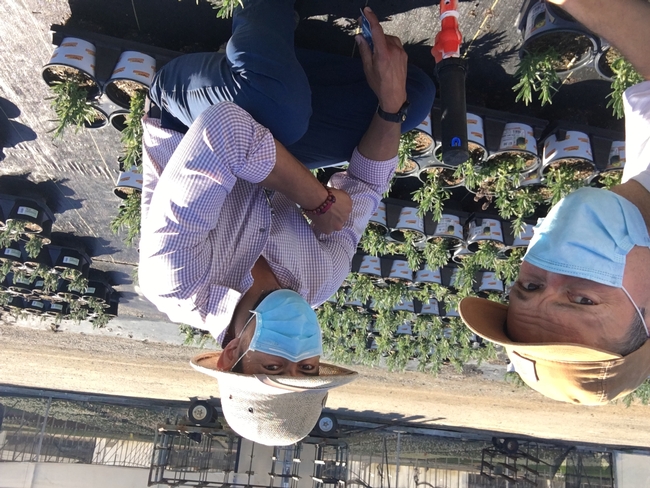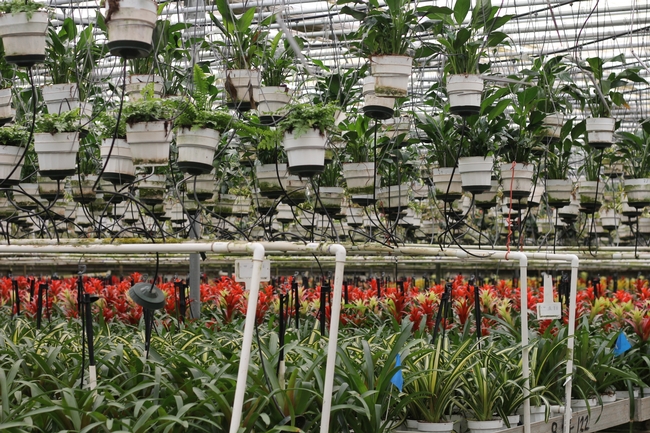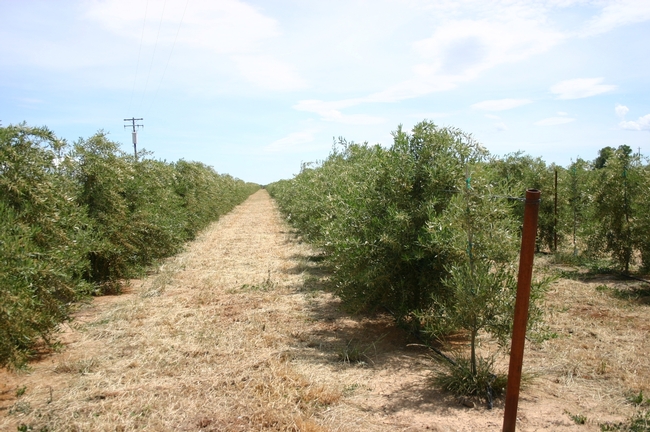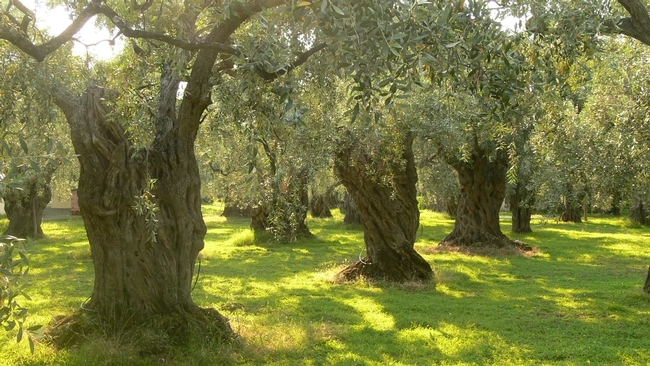
Posts Tagged: Olive
UCCE San Diego advisor educates growers on complex water regulations
‘Ag Order' for San Diego County expected to be enforced by end of 2023
Generally known for its steady warmth and picturesque beaches, San Diego County is also home to nearly 5,000 small farms and is an economic hotspot for nurseries and floriculture. But the great diversity of ornamental crops that dominate the growing region and complexity of regulations make compliance challenging for growers, some of whom grow over 400 crop varieties.
“The regulatory environment for the growers is still complicated and overwhelming because, along with the Regional Water Board, growers are regulated by the County of San Diego,” said Gerardo “Gerry” Spinelli, University of California Cooperative Extension production horticulture advisor for San Diego County.
To help growers with compliance, Spinelli is prioritizing education and expanding growers' knowledge. By partnering with organizations such as the Farm Bureau of San Diego County and the San Diego Region Irrigated Lands Group, Spinelli works to reach more than 1,200 growers, supporting them as they navigate regulatory agencies.
Formally referred to as the Regional Water Quality Control Boards, the Regional Water Board aims to develop and enforce water quality objectives and implement plans to protect the beneficial uses of California's waters.
A unique place to grow in California
About 10 years ago, the Regional Water Board created the Agricultural Order (Ag Order), a set of rules outlining how growers manage water discharge from agricultural operations.
The new Ag Order for San Diego County, expected to be enforced by the end of 2023, will focus on nitrogen management and groundwater quality. However, new considerations are needed to address the variety of crops grown by a single farmer, a common practice in San Diego.
Calculating nitrogen input and output for more than 400 crop varieties is not feasible for small farmers, a challenge exacerbated by the meticulous attention needed for San Diego's high-end specialty crops like ornamentals, native plants and specialty fruit.
Furthermore, many San Diego growers have limited expertise and experience because they are entering agriculture as a second or third career. Many have become “accidental growers” in that they purchased land with a preexisting avocado or cherimoya grove, for example.
To help address these challenges, the grower community is emphasizing the need for more educational opportunities that are accessible and relatable.
Equipping growers through education
Enrico Ferro, president of the San Diego Region Irrigated Lands Group – a third-party entity that manages water sample testing on behalf of growers – has relied on Spinelli's teaching to “bridge the gap” for growers, including himself.
“Gerry has been great because he has expertise in nurseries, but the educational content he creates is relevant to all growers,” said Ferro, who is an avocado and citrus grower in San Diego's North County.
Spinelli, who specializes in containerized production in nurseries and floriculture, has been instrumental in providing technical assistance to growers since he joined Cooperative Extension in 2020.
“I started teaching over Zoom since I became an advisor during the pandemic, and I try to cover different topics for each training,” Spinelli said, adding that he teaches in English and Spanish, making his content more accessible to the grower community in San Diego.
For in-person educational opportunities, Spinelli created the “Last Wednesday” monthly meetings hosted at the Farm Bureau of San Diego County, which brings together growers and other agricultural experts to learn from one another.
“We try to get our information out in creative ways and Gerry is instrumental in that. He's our primary source of really wonderful information delivered in an engaging way,” said Tasha Ardalan, program coordinator for the SDRILG. “He's proactive and is always willing to try new things, too.”
Planning for San Diego's agricultural future
Currently, the Ag Order is modeled around regulations for the Central Valley. As conversations and planning for San Diego County continue, Spinelli is supporting the Regional Water Board with information on nurseries and greenhouses in hopes that the final Ag Order will better serve San Diego growers.
“I'm trying to help others understand how nursery and greenhouse production systems function, and how and why they are different from an almond orchard or tomato field in Fresno,” explained Spinelli.
Michael Mellano, CEO of Mellano & Company, a fresh cut flower grower and distributor in Oceanside, feels the impact of the Ag Order and its failure to account for variability. Growing over 100 varieties of flowers, Mellano said that for several plants there is little scientific research on how much nitrate to apply.
“Farmers want to do a good job. We make mistakes and we try to fix them as quickly as we can, and we try to educate others on what works,” said Mellano, who is also a member of the SDRILG.
Growers like Mellano and Ferro agree that the farming community in San Diego needs to be given the latitude to solve problems within their means, an ability that requires an understanding of San Diego's uniqueness.
“San Diego is significantly different, and we need an Ag Order that is reflective of our differences,” said Valerie Mellano, SDRILG consultant and former UCCE environmental issues farm advisor. “In developing the new Ag Order, there's a huge opportunity for education and research, something that we know Gerry can easily do and continue to support us in.”
Thus far, Spinelli's educational content has reached two-thirds of SDRILG's 1,200 members. In addition to the live training sessions, growers can watch videos that cover topics such as evapotranspiration, irrigation distribution uniformity, water quality indicators and more on Spinelli's YouTube channel.
Since the Ag Order requires all growers to complete two hours of water-quality education, the SDRILG has agreed to apply one hour of credit to growers who attend a one-on-one session with Spinelli.
As San Diego's growers continue to leverage educational opportunities – whether it's alongside Spinelli, SDRILG or learning from one another – Spinelli emphasized that their success also relies on an ag order that adheres to a distinctive landscape, multitude of specialty crops and growers with varying expertise.
The Achemon Sphinx Moth: A Lovely Beast, Indeed
It is indeed a “lovely beast,” as lepidopterist Art Shapiro, UC Davis...
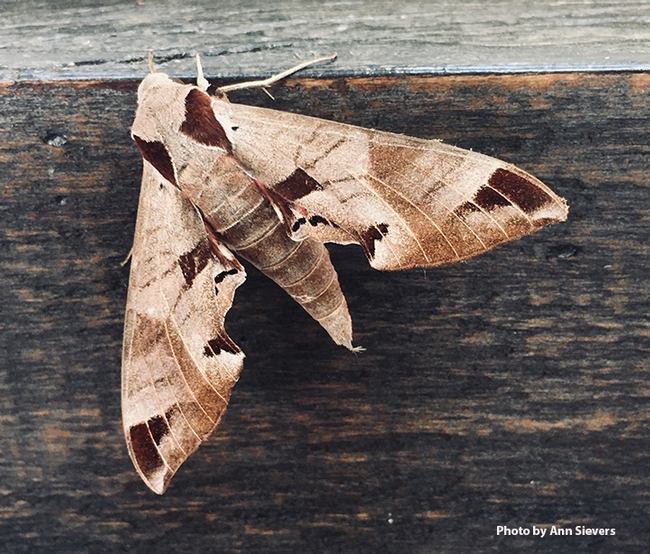
Eumorpha achemon, the Achemon Sphinx, is a "lovely beast," says UC Davis distinguished professor Art Shapiro. Ann Sievers, owner, grower and miller Il Fiorello Olive Oil Co., recently found this one the wall of her patio. (Photo by Ann Sievers)
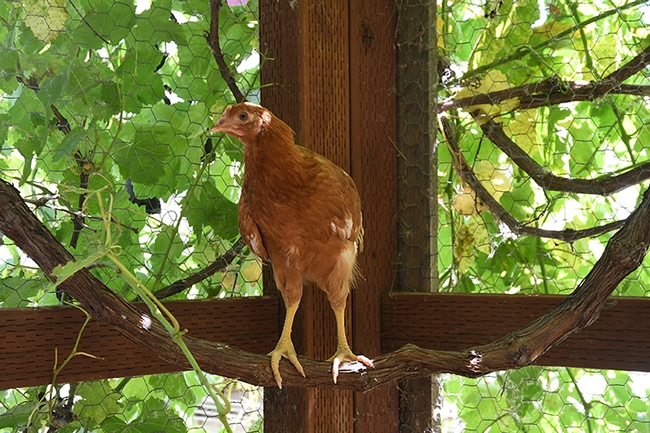
What's for lunch? A chicken in one of Ann Sievers' flocks at Il Fiorello Olive Oil Co., eyes the photographer. Chickens eagerly eat lots of bugs--if they're available. The larvae of the Achemon Sphinx moth feed on grape leaves. (Photo by Kathy Keatley Garvey)
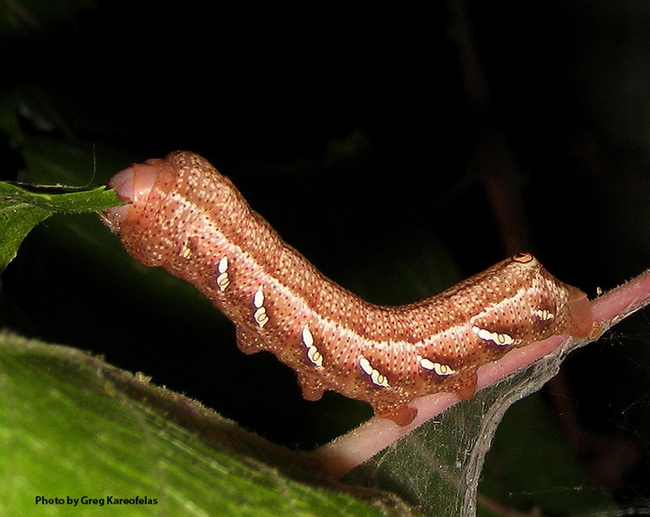
Naturalist-photographer Greg Kareofelas took this image of an Eumorpha achemon larva in his yard in Davis several years ago. It was feeding on native grape, Vitus californica. (Photo by Greg Kareofelas)
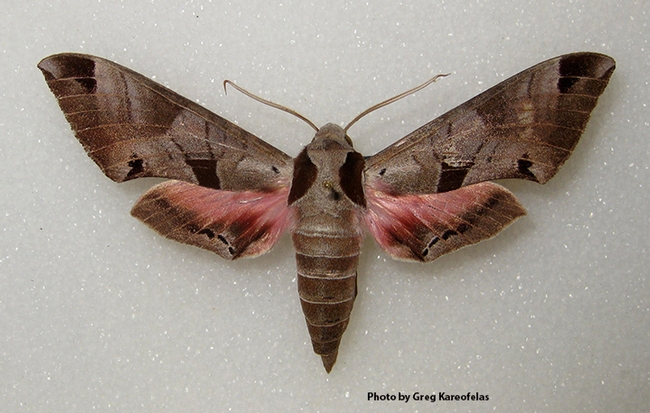
An adult Eumorpha achemon, photographed by naturalist-photographer Greg Kareofelas in his yard in Davis several years ago. It was feeding on native grape, Vitus californica. (Photo by Greg Kareofelas)
Food bloggers see innovative olive oil production system in Capay Valley

The writers heard about innovations in olive oil production that have allowed California producers to minimize labor costs and maximize yield and quality by establishing super-high-density orchards. Farm manager Joe Armstrong led a farm tour, explaining amendments that had to be added to the soil before planting, the configuration of the trees in hedgerows and an irrigation system that permits application of water to the trees exactly when it is needed.
A graduate of California Polytechnic State University, San Luis Obispo, Armstrong said he choose a career in agriculture precisely because of the new technologies that make the field more efficient and productive.
"That's why I have a passion for farming," Armstrong said.
Ranch owner Chris Steele, who has farmed in Capay Valley his entire life, recognized how such innovations are brought to the farm.
"We couldn't do this without the UC system," he said.
UC Cooperative Extension advisors and specialists have worked alongside farmers to adapt the new super-high-density orchard systems. The idea was conceived in Spain and introduced into California in the 1990s. Successful use of high-density olive farming requires careful variety selection; finessed pruning, fertilization and irrigation practices; and understanding the cost-and-return for adept decision-making. This month, UCCE scientists released a new cost-and-return study specifically for farmers to use when planning new olive orchards under the super-high-density planting configuration.
Students' olive-oil fraud buster wins international prize

The award was presented to the Aggie inventors during the finals of the three-day global iGEM (International Genetically Engineered Machines) competition in Boston. The competition, this year featuring 245 teams from Asia, Europe, Latin America and North America, challenges student teams to design and build biological systems or machines and present their inventions in the international competition.
The students had spent several months designing and building the palm-sized biosensor, which they dubbed OliView. The biosensor is equipped to quickly and easily evaluate the chemical profile of oil, providing producers, distributors, retailers and ultimately consumers with an effective, inexpensive way to ensure olive oil quality.
Verifying olive oil quality is a concern for consumers – many of whom are willing to pay higher prices for the health benefits and flavor of true, extra-virgin olive oil. And honest olive oil producers want to prevent other producers from passing off sub-par olive oil as the real deal, while retailers, distributors and producers want a quick, easy way to ensure olive oil quality.
In addition helping detect fraudulent olive oil, the students' new biosensor will also monitor for good oil that may have gone rancid with age.
The team of undergraduate students included Lucas Murray, Brian Tamsut, James Lucas, Sarah Ritz, Aaron Cohen and Simon Staley, with Yeonju Song serving as the “shadow” or alternate team member. You can tune into Aaron Cohen's recent Nov. 6 Science Friday interview during a discussion of synthetic biology.
The full story and a brief video about the new olive-oil biosensor and this stellar team of young inventors are available at: http://news.ucdavis.edu/search/news_detail.lasso?id=11076.
Reports on olive-oil quality are available at the web site of the UC Davis Olive Center at: http://olivecenter.ucdavis.edu/research/reports.
Her Name Was Olive
Her name was Olive. Every Friday morning she'd come bounding over to greet me, her tail wagging...

Olive attentively watches for Kris Kolb. (Photo by Kathy Keatley Garvey)

Sarah Hodge pets Olive, while Kris Kolb gardens. (Photo by Kathy Keatley Garvey)

Olive faithfully follows Kris Kolb as she hauls away clippings. (Photo by Kathy Keatley Garvey)

